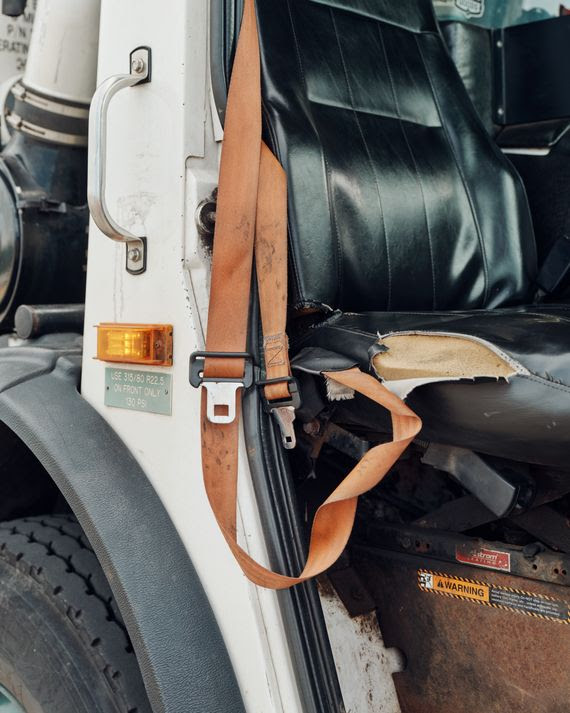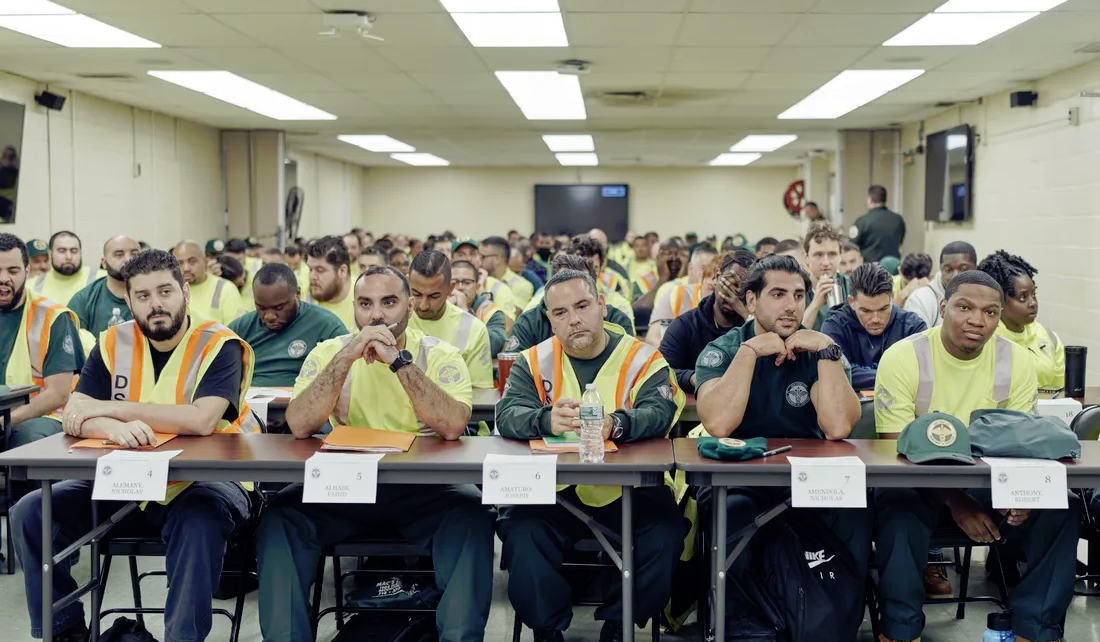PHD From Trash University
An education in “juice,” how to protect your shins, and keeping 12,000 daily tons of garbage at bay.

The white elephant, as it is sometimes affectionately called, is the Department of Sanitation’s standard collection truck. There are currently 2,100 of them in the city fleet, all standing nearly 12 feet high and 33 feet long. The vehicle’s tailgate — the overhanging rear end that raises skyward while the truck dumps mounds of garbage — is held in place with two locking pins, like hinge joints in a massive body. Hydraulic oil pumps through veinlike cylinders, with a nervous system composed of color-coded levers: red, red, black.
At 6:30 a.m. on a Wednesday morning in August, as the sun burns off the ocean mist at Floyd Bennett Field, I am standing alongside around a dozen other people, staring into the elephant’s hopper — the familiar gaping maw into which workers feed trash bags — as it slowly closes shut with a satisfying clank. The hulking blade that compacts the trash moves in a single, sweeping motion. We watch with quiet concentration. Over the sound of the rusty metal, the man operating the truck, in black sunglasses and a crew cut, yells: “Garbage goes in, then what goes out?” In unison, we respond: “Juice!”
Trash juice, the viscous concoction brewed by the contents of every truck, and its habit of spraying out of bags as they’re compacted, is a major theme at the Department of Sanitation’s Ronald F. DiCarlo Training Academy, where I have unofficially joined New York’s Strongest for two days to try and learn how to collect, sort, and dump the 12,000 tons of trash the city produces on a daily basis. “In New York City, nobody finishes a cup of coffee,” our instructor, Sergio Serrano, a spirited DSNY veteran with a bushy beard that I assume is full of knowledge, tells us. “You will know the flavor of the month and come to hate the flavor of the month.” To emphasize the point, Joe O’Hare, another instructor who works at the same garage, shouts, “Pumpkin spice latte!”

The cohort of trainees I’m with are largely dressed in DSNY-branded green shirts (with mandated reflective stripes for visibility). The uniform has become a coveted streetwear item, and when I arrived that morning I thought I might get one. Instead, I’m issued a gigantic orange vest that makes me look like a baby, but maybe, I hope to myself, one with an important job to do.
The group I’m with is just one crew among the 141 trainees going through Trash School this month. We’re assembled at different stations — most of them trucks — positioned around what was once the city’s first municipal airport. Because there is no actual garbage in the training field, we must imagine bags of trash and piles of disassembled furniture as we go through the motions of loading the trucks. We rotate between four different vehicles — a front-loading E-Z pack that hoists dumpsters, a salt spreader for snow control, a split-body truck for recyclables, and the aforementioned white elephant. My fellow trainee Lynn Haynes dutifully listens to the instructors’ every word as she prepares for her turn. We briefly confer, agreeing that the spreader is the easiest. When we get to the collection truck, someone pulls the lever and the tailgate lifts. Suddenly, a brackish liquid the consistency of spittle pours out, and we step back to avoid the splash. “Juice,” Haynes says, pointing to it. “Juice,” I repeat solemnly.
The DSNY civil service test is typically offered every four to five years, but a pause in the early pandemic meant that the last time the test took place was in 2015, when over 80,000 people sat for it, including everyone I’m pretend-loading trash trucks with at seven in the morning in 80-degree heat. Some trainees, an instructor told me, had forgotten they’d taken it altogether.
Getting to Floyd Bennett Field means you’ve passed the test and are among the lucky few to get a call from the city in its latest hiring round — the last person hired from the current class was number 11,080 on the list. The basic training runs for a month, and takes place multiple times over the summer. It includes everything from defensive driving to fitting snow chains on tires. I’m allowed to do everything except drive the truck, something the chief of training is very firm on, and which I spend the next 48 hours trying and failing to change his mind about.


The other trainees, each of whom can drive the truck, are former corrections officers, teachers, photojournalists, and tech workers. The stories of what brought them there were familiar: too few hours, bad pay, layoffs. One told me he made his son take the test with him and now they were both DSNY employees. Another took the test in high school because his dad was a DSNY worker. (Over a quarter of the trainees had family on the job.) Haynes seems to be one of the few people who took the job because she loves trash (compost, specifically) and shows me photos of her garden — a fig tree, candy-stripe peppers — while we chat about the finer points of decaying organic material.
The job can be about as gross as you might imagine. Instructors rattle off the most repulsive things they’ve encountered on their routes — a pig’s head, an entire lamb, “disco rice,” which is a deceptively appetizing name for maggots — with bravado. But it’s also a union job and a clear path to a middle-class life in the city. The starting salary is $40,622, which more than doubles after five and a half years on the job. There’s a pension, and opportunities for overtime and growth. Trainers told me that the hardest part of the job was the schedule, which can be erratic in early years and difficult to maintain with a family, but everyone seemed relieved to be there.

For decades, DSNY workers made far less than city cops and firefighters, and worked in dangerous conditions without sick time and for lower pensions. But in February of 1968, the department’s 10,000 uniformed workers went on a wildcat strike, led by their union founder and president John DeLury. Tens of thousands of pounds of trash accumulated over a week, with a major snowstorm threatening to bury it all. Then-Mayor John Lindsay claimed that if the city submitted to the sanitation workers’ demands, “seldom again would a municipal contract be agreed to on its merits. The only weapon will be raw, self-interested power.” The union won, securing better wages and benefits. One striking worker recalled stepping back out onto his route in the South Bronx to sounds of applause.
More than half a century later, with more strikes holding the line, a job with the department now meant saving up for a house, good insurance, a respected career. Twenty-two years — the amount of time until DSNY employees can begin drawing on their pension — had become a kind of mantra. “I haven’t had a bad day yet,” Serrano tells us during baskets training, grinning. “And in 22 years I’ll be sipping a mai tai.”
The trash truck obstacle course is the event everyone seemed to be waiting for. Orange traffic cones have been set up around the lot to imitate a tight street circuit. A row of white elephants are at the ready as a group of trainees stand in a huddle around the instructors. Derick Rodas, another instructor and former mechanic, preps the class, warning us not to hit the cones, which he calls “my kids and future Nobel laureates.”
Since I am not allowed to drive the truck simply because I do not have a commercial driving license (a tiny detail in my opinion), I am paired on the obstacle course with Matt Prevosti, who has worked at DSNY for three years and coaches baseball in his spare time. We’re high off the ground, and every bump in the road bounces me in my seat. Each truck has two sets of wheels and brakes, but only one person can drive at a time. (Again, not me.) Prevosti tells me, though, that both people can hit the brakes, since the truck has blind spots. I ask him whether he and his partner ever use the brakes to prank each other. He pauses and says, “No.” Then smiles.
The rest of the trucks begin moving around the tarmac, like the world’s slowest go-kart race. I watch as most people hit a cone or two and silently weep for Rodas’s fallen Nobel laureates. As the month of training progresses, the obstacle course will get more difficult to better mimic a chaotic city street. (They used to haul in totaled cars for the sake of realism.) The navigation is hard; even Prevosti ends up knocking over a cone.


Next up is baskets training, where we learn how to pick up and empty the city-issued corner trash cans. The maneuver seems simple enough — pick up a basket, tip it, bang it a few times to knock loose any straggler trash, then close the hopper by pulling a lever. I try lifting one. Even empty, it easily weighed 30 pounds. My heart raced and my arms trembled. After I had tipped it into the truck, I was instructed to drop it rather than set it down to expend less energy, which meant almost crushing my toes, something I forgot I had also been instructed to carefully avoid. Now, the instructor says, imagine doing that 400 times on a single route. (I did not want to imagine this.)
We then run through things to watch out for on the job: bent license plates will slice up your knees, tow hitches on trucks will bruise your shins. We’re advised to avoid steel-toed boots, since they won’t stop a truck from crushing your foot and the metal might slice your toes off. Serrano, at one point, hands around his phone with a gory photo of a huge leg gash he got from a sharp object hidden in a trash bag.

Trash pickup ranks among OSHA’s list of occupations with the highest fatal work injuries. There’s heavy machinery and the unpredictability of New York City streets, where drivers run amok. But there’s also the slow deterioration that comes with the intense physical labor. Over the years, bodies that must lift and carry all that weight — bend and contort and move — wear down. Safety, maybe even more than trash juice, is the heart of the training. Sanitation employees often work in twos and our training emphasizes that partnership is a foundational principle in the department. You’re not always paired with the same person, but you are responsible for each other all the same. These are workers who ultimately want to keep each other whole, and for an industry that consists of 90 percent men, the vibe on the field is surprisingly sweet and supportive.
On my last day of training, as a reward for successfully changing a single truck tire (it was hard and I will not be doing another), Rodas takes me out for a drive on the salt spreader. We clank through the back roads of Floyd Bennett, the pavement streaked with tire tracks from what look like the previous night’s drag races, passing kayakers out on glistening Jamaica Bay. We chat about the morning, the work, the weekend. Rodas returns again to the idea of partnership, one that includes the whole city, whether people realize it or not. New York produces a lot of trash, and all of it must be picked up. (More often than not, I’ve learned, by men carpooling from Staten Island.) There’s an unspoken relationship in the work, he says — “someone else picking up the bag on the other side.” Then we’re back to joking around. I propose that we skip the rest of the day and take the truck to the beach. “No problem,” Rodas laughs, and for just a moment, as he points the truck toward the early-afternoon sun, I think he might be serious. There’s plenty of trash there, too.
PHD From Trash University By Going To Trash School







